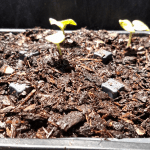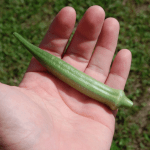Fried. Boiled. Baked. Pickled. Okra can be eaten any number of ways. Last year I was successful at growing okra, my only problem was I didn’t plant enough to please my youngest son nor did I continue to plant during the season, aka succession plant. So this year, I’ll be sowing seeds every 10 days or so in order to have plenty of okra to harvest all summer long. Succession planting of your crop is vital if you want to harvest all season, okra is no exception although it is a vegetable that will continue to grow after you harvest each pod.
Cold weather is okra’s biggest adversary; plants are stressed by it and may suffer from Verticillium and Fusarium Wilt which will cause the plant to die. Ants are also drawn to the plants nectar but generally do not pose a hazard, the exception are fire-ants. Fire-ants will damage emerging flowers and cause the plant to terminate production.
Here is how I have been attempting to get my seeds to germinate, a paper towel that I soak 2-3 times per day and leave on window sill that gets plenty of sun. Okra seeds germinate in approximately 7-10 days and its first leaves form in about 17-21 days. Okra grows best when the daytime temperature is above 82° and the night-time temperature is above 60°, for us here in Zone 9 that is just about early to mid-April. Okra grows slowly at first but takes off when temperatures rise and summer fully sets in.
The recommended soil PH is between 6.5 and 7.0, the soil should contain lots of compost. Okra is drought tolerant but excels when given an inch of water per week.
Once okra begins to flower, expect pods shortly thereafter. Pods are best picked when they are between 2 and 5 inches long. I recommend using a good set of shears to harvest the pod. It is recommended to leave a small portion of the stem on the pod when harvesting. The pods can and do grow quickly, sometimes in as little as two days, although 3-4 days is the norm. If you let the pod grow longer than 5 inches, it tends to get “woody” and tough and isn’t as appetizing as the smaller pods. I highly recommend checking on your plants every day and harvesting what you can.
My son and I like to harvest the pods, cut them into bite size pieces, leave them out to dry for an hour or so then we prepare them to be fried by coating them with breadcrumbs. We then freeze the raw okra until we have enough for a meal. Let me know how you like yours.
Until next time, have fun in your backyard while growing your favorite veggies





